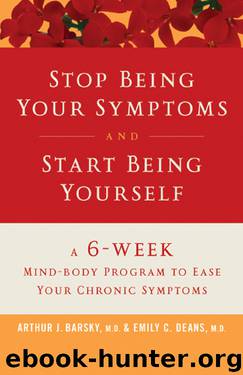Stop Being Your Symptoms and Start Being Yourself : The 6-week Mind-body Program to Ease Your Chronic Symptoms by Arthur J. Barsky M.D. & Emily C. Deans M.D

Author:Arthur J. Barsky, M.D. & Emily C. Deans, M.D. [M.D., Arthur J. Barsky, & M.D., Emily C. Deans,]
Language: eng
Format: epub
Published: 2011-01-07T04:10:11.445000+00:00
S T O P B E I N G Y O U R S Y M P T O M S A N D S T A R T B E I N G Y O U R S E L F
don’t truly accept that you’re going to have to make the most of your condition, and you don’t develop the coping skills and strategies that would allow you to overcome it.
In addition, there are other risks involved in overaggres-sive treatment of conditions that are uncomfortable but aren’t terribly serious. These risks include experiencing medication side effects, developing resistance to antibiotics or rebound pain from pain medications, becoming weaker from unnecessary activity restrictions, and having secondary problems like missing work or family obligations. By asking the question “How might I try to improve my situation regardless of my medical condition?” the door is opened for improving your quality of life.
Ellen and her primary care physician discuss Ellen’s risk factors for breast cancer. She does have an increased risk due to her mother’s illness, but no other relatives have the disease. She is thirty-two, and breast cancer at such a young age is very rare.
Ellen wants a mammogram, but her doctor warns her that mammograms in young women are difficult to read and have false-positive results more often than in older women. Indeed, if the chances of Ellen actually having a cancer are very small, a positive test is more likely to be a false positive than a true positive.
False-positive mammograms can lead to unneeded biopsies, which cause pain, scarring, and can be complicated by infection. Ellen’s doctor does not feel any suspicious lumps and wants Ellen to wait a few years before her fi rst mammogram.
We seek reassurance in many direct and indirect ways. Direct ways include asking family members or friends, “How do you think I look?” Perhaps you call your physician to report that the flu symptoms have improved and wait for her to say, “You’ll be fine now.” There are indirect ways to seek reassurance: sneaking references to health into a store checkout lane conversation, scanning WEEK 4—UNDO THE DAMAGE OF UNPRODUCTIVE BEHAVIORS
123
magazine articles that explain which symptoms indicate serious disease. You might ask an aunt, “Can lightheadedness be caused by multiple sclerosis? Does MS run in our family? Did you ever know anyone with MS?” When she replies she had a coworker who did develop MS, it confirms your suspicion that the disease is common, and your fear that it is the cause of your lightheadedness.
Think back to a recent doctor’s appointment. Did you feel reassured after the visit? How long did the reassurance last? What usually happens when you go to the doctor? Some of you may notice that even when you get the response you thought you wanted, the reassured feeling doesn’t last for long. The worries creep back in, and you may question or disregard what was said. Anxious people replay the visit over and over, worrying they did not convey their situation accurately, so the doctor didn’t get the right picture.
Download
This site does not store any files on its server. We only index and link to content provided by other sites. Please contact the content providers to delete copyright contents if any and email us, we'll remove relevant links or contents immediately.
Men In Love by Nancy Friday(4975)
Everything Happens for a Reason by Kate Bowler(4487)
The Immortal Life of Henrietta Lacks by Rebecca Skloot(4271)
Why We Sleep by Matthew Walker(4202)
The Sports Rules Book by Human Kinetics(4087)
Not a Diet Book by James Smith(3162)
The Emperor of All Maladies: A Biography of Cancer by Siddhartha Mukherjee(2941)
Sapiens and Homo Deus by Yuval Noah Harari(2858)
Day by Elie Wiesel(2603)
Angels in America by Tony Kushner(2398)
Endless Forms Most Beautiful by Sean B. Carroll(2358)
A Burst of Light by Audre Lorde(2355)
Hashimoto's Protocol by Izabella Wentz PharmD(2209)
Dirty Genes by Ben Lynch(2170)
Reservoir 13 by Jon McGregor(2152)
And the Band Played On by Randy Shilts(2023)
Wonder by R J Palacio(2000)
The Immune System Recovery Plan by Susan Blum(1974)
Stretching to Stay Young by Jessica Matthews(1951)
